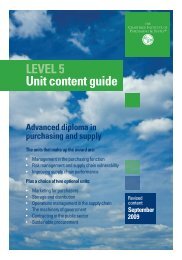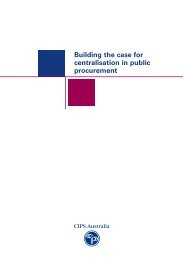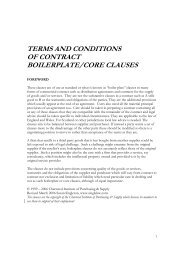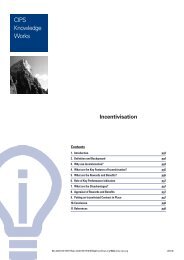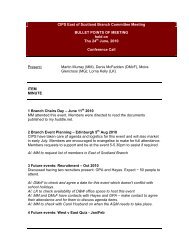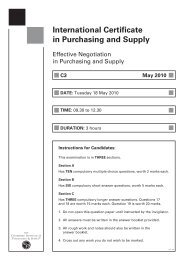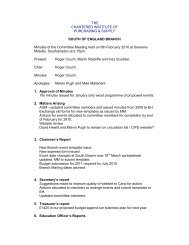Graduate diploma - The Chartered Institute of Purchasing and Supply
Graduate diploma - The Chartered Institute of Purchasing and Supply
Graduate diploma - The Chartered Institute of Purchasing and Supply
Create successful ePaper yourself
Turn your PDF publications into a flip-book with our unique Google optimized e-Paper software.
DELIVERY OF THE UNIT<br />
<strong>The</strong> role <strong>of</strong> the college provider is<br />
likely to be as a facilitator. Classes<br />
should focus on case analysis<br />
techniques <strong>and</strong> practice based<br />
around past papers, as well as<br />
general help <strong>and</strong> advice. It is not<br />
envisaged that classes or<br />
workshops on specific supply chain<br />
subjects are <strong>of</strong>fered for this unit.<br />
This is because examination<br />
questions are based on the content<br />
<strong>of</strong> the other two Level 6 units:<br />
Leading <strong>and</strong> influencing in<br />
purchasing <strong>and</strong> Strategic supply<br />
chain management.<br />
Suggested case study analysis<br />
technique<br />
Step one: Determine the problem<br />
<strong>The</strong> case should be read several<br />
times, starting with a quick review<br />
<strong>of</strong> the overall situation <strong>and</strong><br />
culminating in a detailed<br />
identification <strong>of</strong> the problems<br />
involved <strong>and</strong> a thorough<br />
underst<strong>and</strong>ing <strong>of</strong> the organisational<br />
context. <strong>The</strong> important aspect <strong>of</strong><br />
this step is to determine whether a<br />
particular occurrence is a problem<br />
or whether it is a symptom <strong>of</strong> the<br />
real problem. Determination <strong>of</strong><br />
problems invariably requires<br />
delving beneath the surface <strong>of</strong> the<br />
case to uncover factors that are<br />
relevant but not obvious in a casual<br />
review.<br />
Step two: Determine<br />
alternative courses <strong>of</strong> action<br />
During this step there is a great<br />
deal <strong>of</strong> brainstorming in an attempt<br />
to account for as many alternatives<br />
as possible. Obviously not all<br />
alternatives will be equally viable<br />
but it is important not to arbitrarily<br />
discard any at this stage.<br />
Step three: Evaluate alternative<br />
courses <strong>of</strong> action<br />
After identifying alternative<br />
courses <strong>of</strong> action, it is necessary to<br />
evaluate the strengths <strong>and</strong><br />
weaknesses <strong>of</strong> each alternative.<br />
Some will obviously have more<br />
merits than others but the main<br />
point is to determine the<br />
alternative that addresses the case<br />
problem with respect to both the<br />
short term <strong>and</strong> the long term. It is<br />
critical that the consequences <strong>of</strong><br />
each alternative are considered<br />
because what may appear to be an<br />
obvious course <strong>of</strong> action now, may<br />
lead to dysfunctional effects in the<br />
future.<br />
Step four: Select <strong>and</strong> justify<br />
alternatives<br />
After weighing the pros <strong>and</strong> cons <strong>of</strong><br />
each alternative, it is then necessary<br />
to select the alternative that has<br />
emerged as the most attractive<br />
course <strong>of</strong> action for dealing with the<br />
particular problems at h<strong>and</strong>. It is<br />
27<br />
important that factual ammunition is<br />
obtained that will enable a clear<br />
justification for the choice that is<br />
made.<br />
Step five: Implement selected<br />
alternative<br />
<strong>The</strong> case analysis process is not<br />
concluded until a suitable plan has<br />
been developed for implementing the<br />
selected course <strong>of</strong> action. Improper<br />
implementation will negate the time<br />
<strong>and</strong> effort spent up to this point.<br />
Case study examination<br />
<strong>The</strong> case study assessment is via a<br />
three-hour open-book examination.<br />
<strong>The</strong> examination questions will draw<br />
on material from the other two Level<br />
6 units: Leading <strong>and</strong> influencing in<br />
purchasing, <strong>and</strong> Strategic supply<br />
chain management. Furthermore the<br />
content <strong>of</strong> the compulsory units<br />
within the Level 5 Advance Diploma<br />
qualification is assumed as<br />
underpinning knowledge. Students<br />
are therefore strongly advised to<br />
complete all other units before<br />
attempting the case study. <strong>The</strong><br />
examination is testing the ability <strong>of</strong><br />
the c<strong>and</strong>idate to apply relevant<br />
principles to address particular<br />
circumstances <strong>and</strong> solve specific<br />
problems.







